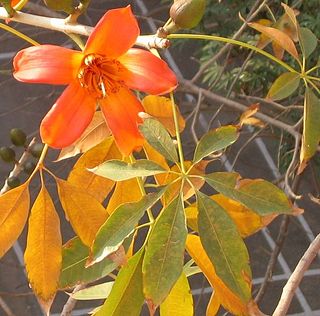
Bombacaceae were long recognised as a family of flowering plants or Angiospermae. The family name was based on the type genus Bombax. As is true for many botanical names, circumscription and status of the taxon has varied with taxonomic point of view, and currently the preference is to transfer most of the erstwhile family Bombacaceae to the subfamily Bombacoideae within the family Malvaceae in the order Malvales. The rest of the family were transferred to other taxa, notably the new family Durionaceae. Irrespective of current taxonomic status, many of the species originally included in the Bombacaceae are of considerable ecological, historical, horticultural, and economic importance, such as balsa, kapok, baobab and durian.
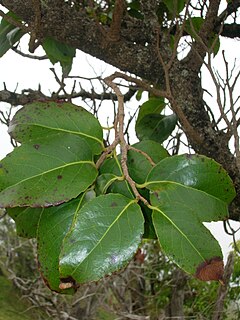
Xylosma is a genus of flowering plants in the family Salicaceae. It contains around 100 species of evergreen shrubs and trees commonly known as brushhollies, xylosmas, or, more ambiguously, "logwoods". The generic name is derived from the Greek words ξύλον (xylon), meaning "wood," and ὀσμή (osmé), meaning "smell," referring to the fragrant wood of some of the species. The Takhtajan system places it in the family Flacourtiaceae, which is considered defunct by the Angiosperm Phylogeny Group.

Abuta is a genus in the flowering plant family Menispermaceae, of about 32 species, native to tropical Central and South America.
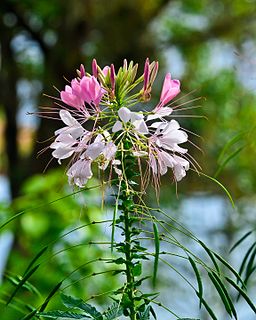
Cleome is a genus of flowering plants in the family Cleomaceae, commonly known as spider flowers, spider plants, spider weeds, or bee plants. Previously, it had been placed in the family Capparaceae, until DNA studies found the Cleomaceae genera to be more closely related to the Brassicaceae than the Capparaceae. Cleome and clammyweed, can sometimes be confused. The simplest way to differentiate the two is to compare the seedpods which project out or down on cleome and up on clammyweed.
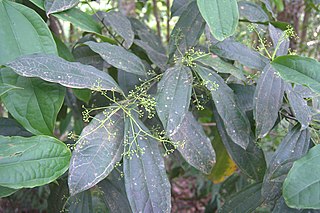
Aiouea is a genus of shrubs and trees in the family Lauraceae. It is native to tropical forests and montane forests of North and South America. The name is a curiosity because it consists entirely of vowels.

Blakea is a genus of flowering plants in the family Melastomataceae. There are about 189 species distributed from Mexico to Bolivia and the Antilles. They are climbers, shrubs, and trees, some epiphytic.
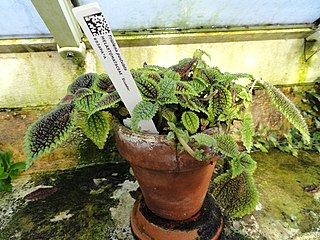
Triolena is a genus of flowering plants in the family Melastomataceae. They are found in southern Mexico southward to Bolivia. As of 1991 there were 20 to 25 species.

Xylopia is a genus of flowering plants in the family Annonaceae. They are mostly trees and some shrubs. There are about 160 species distributed in Asia, Africa, and the Americas.

Tetracera is a genus of flowering plants of the Dilleniaceae family native to the tropics. Several species are lianas.

Hernandia is a genus of flowering plants in the family Hernandiaceae. It was named after the Spanish botanist Francisco Hernández de Toledo.

Schnella is a genus of flowering plants in the legume family, Fabaceae. It belongs to the subfamily Cercidoideae. All of its species are neotropical lianas.
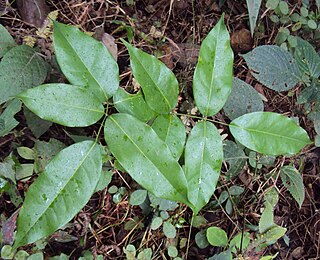
Rourea is a genus of plants in the family Connaraceae. They are found worldwide across the tropics and subtropics.
Morisonia is a genus of flowering plants in the family Capparaceae, found across the Americas from the United States to Argentina. It was recently enlarged with New World Capparis species due to existing taxonomic instability. They tend to be shrubs or small trees.
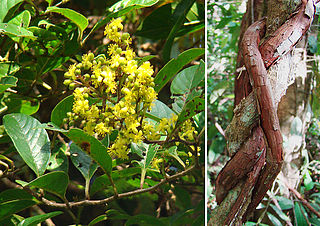
Davilla is a genus of flowering plants belonging to the family Dilleniaceae. It has around 30 neotropical, species and is one of most diverse genera of lianas, vines, erect or scandent (climbing) shrubs.













